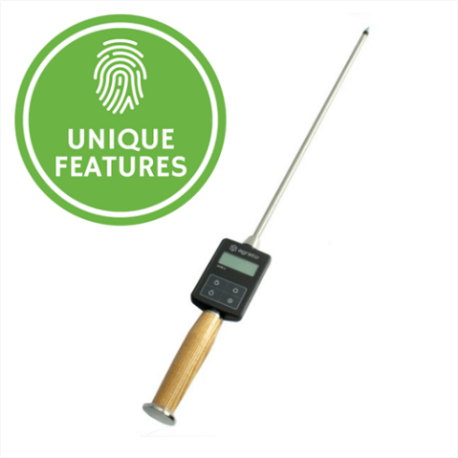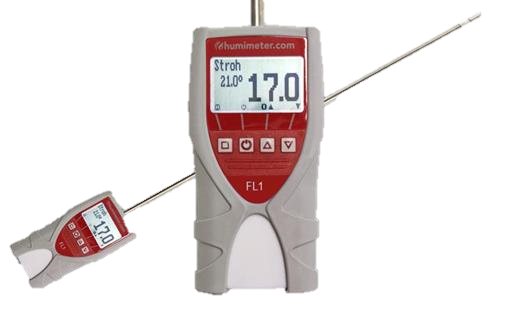What is a Suitable Hay Moisture Level?

The consequences of not monitoring hay moisture levels can be hazardous and costly for your business or farm. Optimum moisture content within hay is of critical importance when baling and storing a safe, stable, and a more valuable product.
In this article, we will examine the importance of measuring hay moisture, and we also provide some examples of specialised hay moisture meters.
About Hay Moisture
Moisture levels, both too high and too low, have a direct effect on hay quality.
Hay at higher than ideal moisture levels;
- High moisture in fodder has a higher probability of developing mould. Mould growth has two key impacts;
- Your product will be less palatable, and mould growth creates heat. Heat can result in large amounts of dry matter and total digestible nutrient loss.
- Under some conditions, mould can produce mycotoxins. Mycotoxins are toxic secondary metabolic products of moulds. These can have both acute and chronic effects (depending on dosage/exposure time) on both ruminant and non-ruminant species.
- Excessive moisture within baled hay can lead to a process called thermal expansion. In short, thermal expansion results in the bale increasing in temperature as moisture tries to escape. Although rare, hay can reach temperatures 180 degrees and at these temperatures, it can combust spontaneously, setting fire to the hay and surrounds. (Ouch!)
When the moisture of hay is too low;
- When the water content of hay is insufficient, there will be a reduction or loss of nutritional value. This loss is because much of the nutritional content of hay is in the leaves of the forage, and when too dry, these leaves fall off before or during baling.
- Palatability – While mould and high moisture affect palatability, so too does low moisture content.
Suitable Hay Moisture Levels
Due to the heterogeneous nature and variability of moisture content found within a bale, it’s common sense to evaluate moisture levels within a range rather than a specific value. It’s near impossible to pinpoint a specific moisture value in fodder.
|
IC Fact: When no mould inhibitor or preservatives are in use, the recommended moisture content for bailing hay is between 18-20%. |
Bale size and density will also mean you can allow for different moisture content levels. For example, small square hay bales are generally less densely packed than large hale square or round bales, so moisture heading towards the higher side of 18-20% may be acceptable, whereas large square or round bales may need to be between 12-16% to ensure stable longer-term storage. These numbers will vary depending on other factors such as temperature, additives used, the baling method, and the type of forage baled.
Hay Moisture Meter Examples
The Instrument Choice scientists have prepared two examples of hay moisture meters that are perfectly suited for monitoring hay moisture.
Hfm II Hay Moisture Meter / Straw Moisture Meter
Product Code: AGFH0010
The AGRETO hay and straw moisture meter HFM II is a professional measuring instrument designed for determining moisture levels plus the temperature of baled hay and straw, and indicative moisture levels in silage.
Consisting of a 50cm stainless steel probe and LCD screen covered in a dustproof and spray waterproof casing, the hay moisture meter is robust and built to last for years, assuring feed quality during harvesting or drying.
Specifications
Moisture Range: 9-70%
Temperature Range: -10 to 100°c
Accuracy: ±0.8% at low moisture levels
Humimeter FL1 Hay and Straw Moisture Meter
Product Code: IC-humimeterFL1
The IC-humimeter FL1 is a moisture meter suitable for fast, accurate, and stable measurements of hay and straw.
Easy to handle, this hay moisture meter features a mounted 60cm stainless-steel probe for bale measurements, as well as a rubber protection cover, which makes the meter robust and suitable for use in harsh environments.
Specifications
Moisture Range: 8-40%
Temperature Range: -20 to 85°c
Accuracy: ±1%
Conclusion
If you want to produce safe, nutritionally dense, palatable, stable, and valuable hay, while also reducing the risk of crop losses, it is critical to monitor hay moisture levels before and after baling. Thankfully with the help of specially designed hay moisture meters, this can be a fast and painless task.
Want more information about any of the products listed above? Want more information about moisture meters? Contact one of the Instrument Choice Scientists. We’re here to help! Call 1300 737 871 or email [email protected].
Also interesting
While your local weather bureau employs sophisticated tools to predict weather conditions, the resulting weather prediction may not always prove reliable for your location. We uncover why this occurs while explaining what a rain gauge is and why they are useful in both rural and residential areas.

Modbus is a type of serial communications protocol. When your weather station utilises Modbus, your programmable controller can monitor and carry out actions based on wind direction, wind speed, temperature, and more, depending on your weather station's functionality.
If understanding and tracking weather is your passion, and if you're curious about process automation, you have to check out Modbus weather stations.



